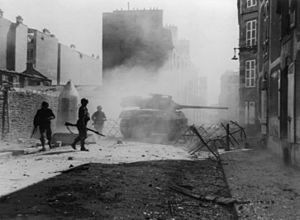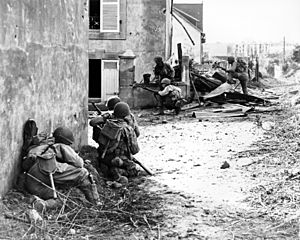Battle for Brest facts for kids
Quick facts for kids Battle for Brest |
|||||||
|---|---|---|---|---|---|---|---|
| Part of Operation Overlord, Battle of Normandy | |||||||
 A US M18 Hellcat of the 705th Tank Destroyer Battalion in the streets of Brest in September 1944 |
|||||||
|
|||||||
| Belligerents | |||||||
| Commanders and leaders | |||||||
| Units involved | |||||||
|
VIII Corps
|
2nd Fallschirmjäger-Division 266. Infanterie-Division 343rd Infantry Division |
||||||
| Strength | |||||||
| 75,000 men | 45,000 men | ||||||
| Casualties and losses | |||||||
| 9,831 killed or wounded | 38,000 captured | ||||||
The Battle for Brest was a major fight during World War II in August and September 1944. It happened on the Western Front in France. This battle was part of a bigger plan called Operation Overlord. The Allies (like the United States and United Kingdom) needed to capture ports in France. These ports were vital for bringing in huge amounts of supplies for their armies.
The Allies estimated that their 37 divisions in Europe would need 26,000 tons of supplies every day. The main port they wanted to capture was Brest. It is located in northwestern France.
Contents
Why Ports Were So Important
Early in the war, the United States and United Kingdom started planning to invade Western Europe. This plan would begin if the United States joined the war. American and Canadian troops would gather in England. Then, they would launch an invasion into mainland Europe.
Supplying the Invasion Army
A big challenge was how to supply the invasion army. They would need tens of thousands of tons of supplies after landing. Capturing ports on the European Atlantic coast was a must. The most suitable ports were clear targets for the invasion.
Without enough supplies, an invading army would get stuck. For the first part of the invasion, large artificial ports were built. These were called Mulberry Harbors. They were set up on the beaches. However, they could only unload a limited amount of supplies. They were seen as a temporary solution until real ports could be captured.
Brest: A Key Target
Many suitable ports were along the northern coast of France. Brest in Brittany was especially important. For a long time, it had been the main French Navy harbor on the Atlantic coast. It was also the westernmost port in France.
Allied planners even thought that after capturing Brest, supplies could come directly from the US. This would bypass England. It would get supplies to the Allied Armies moving towards Germany much faster.
German Fortifications and U-boat Bases
Other important ports included Saint Malo, Lorient, and Saint Nazaire in Brittany. Also, Cherbourg and Le Havre in Normandy were targets. Normandy was chosen as the main invasion landing area.
The Germans knew the Allies would need these ports. So, they built strong defenses around them. This was done by their Organization Todt. These defenses were part of the Atlantic Wall. Some ports were also major U-boat (submarine) bases. They had bomb-proof concrete shelters for submarines. These strongholds had survived Allied air attacks for a while.
Local resistance groups in Brittany helped the Allies. They spied on German naval activity near Brest. They reported when U-boats and other German ships arrived or left. If these U-boat bases fell, German submarines at sea would have trouble finding safe ports.
Getting Ready for Battle
Soon after the Normandy landings, the artificial Mulberry Harbors were brought from England. They were set up on the French coast. But one of them was destroyed by a storm in less than two weeks. After that, supplies were mostly brought ashore directly on the beaches. However, this was not as efficient.
Cherbourg and Brittany
Cherbourg, in Normandy, was captured by American troops. But the German soldiers there destroyed the harbor facilities before they surrendered. Cherbourg was the only major port in the Allied invasion area.
Soon after, German troops in the Brittany peninsula were cut off. This happened when George S. Patton's Third United States Army broke through German lines. The US VIII Corps was sent into Brittany. Their job was to capture Brest. They also needed to protect the side of the Allied breakthrough. This would stop German reinforcements from reaching other battle areas.
German troops trapped in Brittany retreated to the fortified ports. US Third Army troops then surrounded them. The German forces in Brest were called Festung Brest. This means "Fortress Brest" in German propaganda.
German Commander and Forces
The commander of Festung Brest was General der Fallschirmtruppe Hermann-Bernhard Ramcke. He was a paratrooper veteran. His forces included the German 2nd Parachute Division. They also had the 266th Infantry Division and the 343rd Infantry Division. In total, there were about 40,000 German fighting men.
The old fortress city of Saint-Malo was captured by the 83rd Infantry Division on August 17. But its small port facilities were ruined by the German defenders. A German group on nearby Cézembre Island surrendered later. This happened after heavy shelling by warships and strong air strikes. The bombing of the island was one of the first times napalm bombs were used. It became clear that the Germans would try to stop the Allies from using French ports. They would defend their fortresses and damage the docks.
American troops reached Brest on August 7, 1944.
The Battle for Brest
Brest was surrounded and then attacked by the U.S. VIII Corps. The fighting was extremely hard. The German soldiers were well dug in. Many were Fallschirmjäger (paratroopers). There were also German Navy personnel. These included U-boat crews and battleship sailors. Some were survivors from damaged ships.
Tough German Resistance
The German paratroopers fought very bravely. The Allies had seen their tough fighting before, like at the Monte Cassino. While some weaker German units gave up easily, the paratroopers held their ground. They faced huge challenges, heavy shelling, air strikes, and American attacks. The American attackers suffered many losses for every small step they made into the city.
The Americans used their strong artillery and air power. This was part of their military plan. The Germans had stored a lot of ammunition for the city's defense. They had all kinds of weapons. These ranged from light anti-aircraft guns to large naval guns. These weapons were hidden in fortifications and concrete bunkers.
Fighting for Fort Montbarey
Specialized British tanks from the 79th Armoured Division joined the attack. They helped attack the heavily fortified Fort Montbarey. Flamethrowing Churchill Crocodile tanks worked with US infantry. It took them three days to finally capture the fort.
The fighting was very intense. Troops fought from house to house. The old fortifications, both French and German-built, were very hard to capture. Both sides fired heavy artillery.
Eventually, the old city of Brest was almost completely destroyed during the battle. Only some medieval stone buildings were left standing.
General Ramcke surrendered the city on September 19, 1944. He made sure the port facilities were useless first. They could not be repaired in time to help the Allied war effort as hoped. The last German outpost surrendered nearby on September 20. By this time, Paris had already been freed by the Allies. Also, a big operation called Operation Market-Garden was already happening in the Netherlands.
"These are my credentials"
When U.S. Brigadier General Charles Canham arrived to accept Ramcke's surrender, Ramcke asked him to show his official papers. General Canham simply pointed to his nearby troops. He said, "These are my credentials." Canham was the deputy commander of the U.S. 8th Infantry Division. That phrase has since become the division's motto.
The costly capture of Brest led to a new decision. The Allies decided to only surround the remaining German-held ports in France. They would not storm them in a big battle. The only exception was Le Havre. The British 2nd Army captured it on September 12, 1944. Some of these Breton ports did not surrender until May 9, 1945. This was one day after Victory in Europe Day.
After the Battle
The entire Operation Overlord campaign turned out a bit differently than planned. Patton's US Third Army moved very quickly. This allowed the Liberation of Paris to happen earlier than expected.
[[File:Fort Montbarey1.JPG|thumb|Fort Montbary today with a Churchill "Crocodile"]
The U.S. Army sent 75,000 troops to capture Brest. About 10,000 of them were killed or wounded. But not a single Allied troop ship or supply vessel had docked in Brest by the time Paris was freed.
For the French people in Brittany, American soldiers arriving was a joyful sign. Four years of harsh German occupation were ending. Hope was finally near. This was especially true for Jewish people who had been hiding. It was also true for anyone who had problems with the German occupiers.
After the war, the West German government paid money to civilians in Brest. This was for those who had been killed, starved, or lost their homes.
See also
- Liberation of France
- Battle for Brittany
- Saint-Nazaire pocket
- Battle of Saint-Malo




